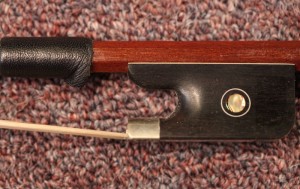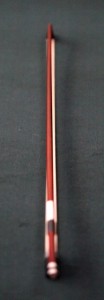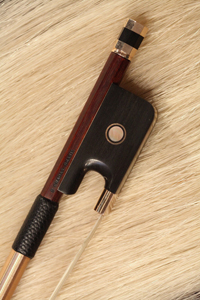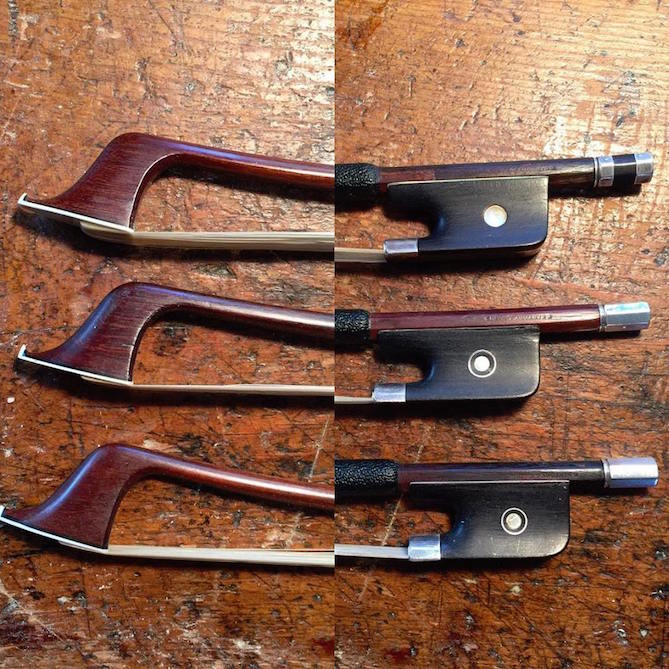
About Those New Year’s Bow Resolutions….
Wayne Burak
New Year’s resolutions get significant attention right about now! Whether the subject is your living space, personal finance, diet, or exercise, every topic seems to be on the table. But what about the personal needs of your favorite bow—you know, the one that plays beside you in all of your performances and rehearsals? The one you have promised your eternal love and gratitude to, if it helps you get through the nearly impossible piece or gig? Hmm, did I think that, you ask?
Bows have long memories, and yes at some point, you did promise. That is why your bow demands attention now! Think of it like dinner, a movie, and a new outfit for your bow.
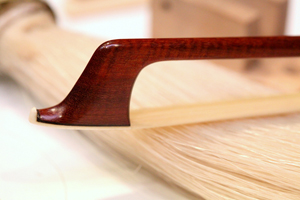
But before we talk more of bows, let’s assume that you have already handled the obvious organization of musical and life stuff because of great personal initiative in 2013!
Just to review, these fine salient points may include:
Organizing your entire paper music library so that you can find the physical sheet music to any piece in a minute. Do the same with digital media. Put things in categories that are meaningful. Carlos Santana string quartet arrangements probably should not live next to Strauss Don Juan.
Having a specific place for all of your cello accessories so there is no serious searching ever needed for strings, rosin, rock stops, electronics, cables, lights, gig stuff, energy bars, etc.
Backing up your cell phone now, so that the unthinkable loss of contacts never happens if the phone crashes, or the battery goes on strike.
Backing up your entire computer to either a stand-alone drive or an online service.
Fixing or replacing anything that is broken which impacts your cello’s protection—whether it’s a case latch or foot that has been missing forever, or the case itself is beyond its usable service life (you can see pavement through it).
And, this also applies to all areas of life—fixing things that absorb time and attention! Everything that is non-working in life takes its toll on productivity, performance, and peace of mind. Happiness = handling stuff.
BOW BASICS
Why not start the year with a fresh rehair? Your trusty bow needs to be able to follow your every whim and intention. If you still have a summer rehair, it is long overdue. Deep inside, you know that old played out hair is a liability. Its in the same category as a missed appointment with your dental hygienist. Your old worn out yellowed hair might even be a subject talked about by contractors who put you behind the new hair people ~!
How does long stretched out hair affect bow performance you ask, in earnest? Answer: the longer it is stretched, the more pronounced is the effect. The most significant issue is a lack of grip in the attack of the string; especially on the C and G. Repeated notes suffer, as there is a delay in the hair’s reaction to direction reversal. Also, the longer it is, the more effect can be felt off the string, generally softening the bounce stroke, slowing spiccato and other bounce strokes’ speeds. This is resultant of the shifting of the thumb’s balance point further frogward. While a larger meatier thumb may not feel a vast difference in position, more of the thumb becomes involved underneath the stick which is not beneficial to a number of bowings. To an average or petite size thumb, this becomes a tension issue, as the space between the grip and frog now offer far more space than can be filled. The thumb either has to be gripped firmer to the frog tongue or slid forward to the leather grip edge.
Illustration 1 is of a typical properly rehaired bow. A proportionate space exists for the thumb, providing excellent support. This is ideal.
Illustration 2 shows a typical condition where the hair is stretched excessively from use and humidity extremes over time. In order for the bow to achieve playing tension, the frog position now is too distant from the grip. It creates an oversize space for the thumb. This is very confusing for your well trained thumb.
Assuming the hair is fine, what other parts are in need of attention? Take an even closer look than usual at things! Is the stick heavily worn in the thumb contact area? Is the frog cracked or chipped on an edge? Is the tip plate cracked, chipped or worst case, entirely missing? Is a pearl eye missing from the frog? Any parts asking for attention need to be replaced, restored or cleaned up. Your bow should be maintained as close to new condition as possible in every structural way! It wants to be happy again.
Illustration 3 is an especially common fix for older bows with substantial wear in the thumb area. The excessive wear is usually filled with a colored resin of some type, which helps reinforce the area, and restore the geometry of the octagonal shape.
Be aware that hair can become looser on one side than the other through wear, giving the impression of a warp in the bow. Bows with hair continuously breaking on the inside players’ edge are a victim of the owner scraping the hair between the stick and string. This is an opportunity to examine the bow grip and stroke before the bow incurs serious damage!
If the bow is not performing at its best despite a hair tune-up, and a look at all of the various parts for functionality, a check of the camber may be in order. The curvature of the bow is crucial to its performance. Years of constant use take a toll on any bow, challenging its strength. The older the bow, the more this becomes an issue, as sometimes the stick tries to return to a straight piece of wood as it once was. Pernambuco wood and its cousins, Ipe and Brazilwood are chosen by bow makers for their exceptional strength and elasticity. One of the most important characteristics of these are their willingness to be bent or cambered by exposure to heat. These woods of course are very amenable to being reheated to reintroduce camber as well. Maybe this is where the saying “don’t get bent out of shape” originates!
Modifying a bow’s camber is an area requiring great background and experience. This type of work should only be entrusted to a consummate professional in the bow-making world, a restorer or advanced rehair person who has had much experience doing the procedure. Do not try to work on your own bow!! Reread the last sentence please.
And finally, it is a good idea to try other bows and experience different options periodically. Trade bows with a trusted colleague at a rehearsal or just for fun occasionally—just make sure you give the bow back… This allows for open-minded comparison of playing qualities. Visit with your favorite bow vendor or supportive dealer to look at other bows. It is very beneficial to have different bows for multiple purposes.
By taking care of your bow and showing it that you care, it will return the attention and be there for you! Promise.
Subjects: Instrument Care
Tags: accessories, attention, bow, bow grip, bow rehair, Brazilwood, Burak, cello, cello bow, cello cases, cello strings, cellobello, computer back up, computers, fresh bow rehair, frog, frog position, humidity, instrument cases, latches, music, New Year's resolutions, organization, organization of sheet music, pearl eye, pernambuco, rock stops, rosin, sheet music, strings, tension, warp, Wayne


